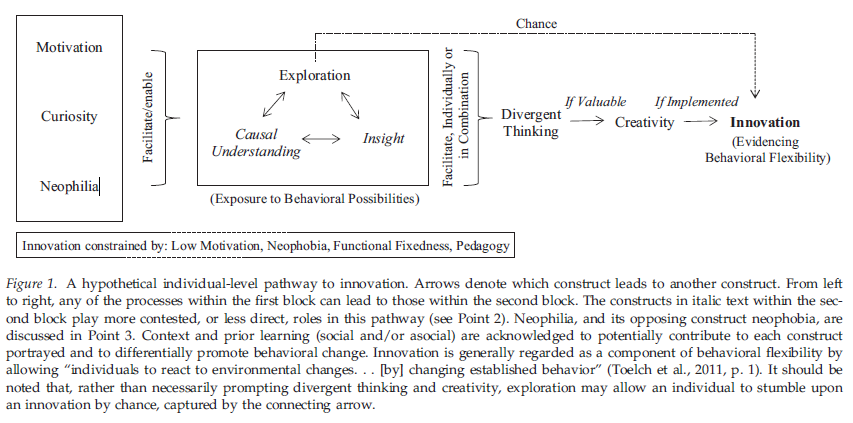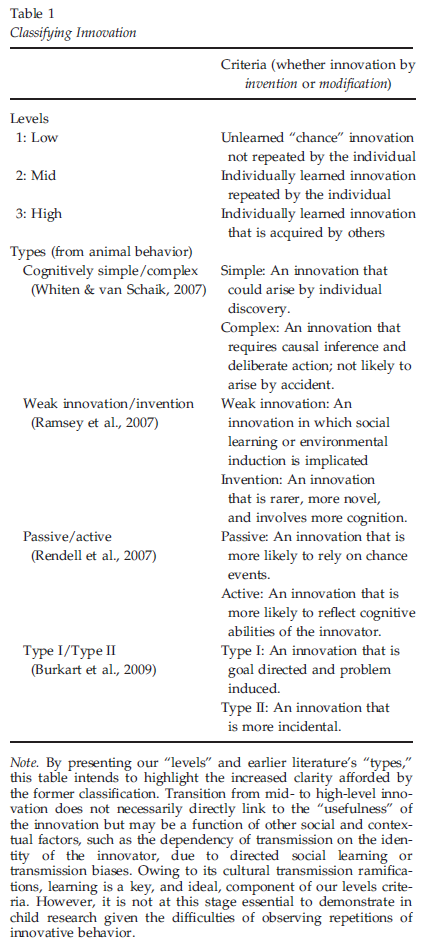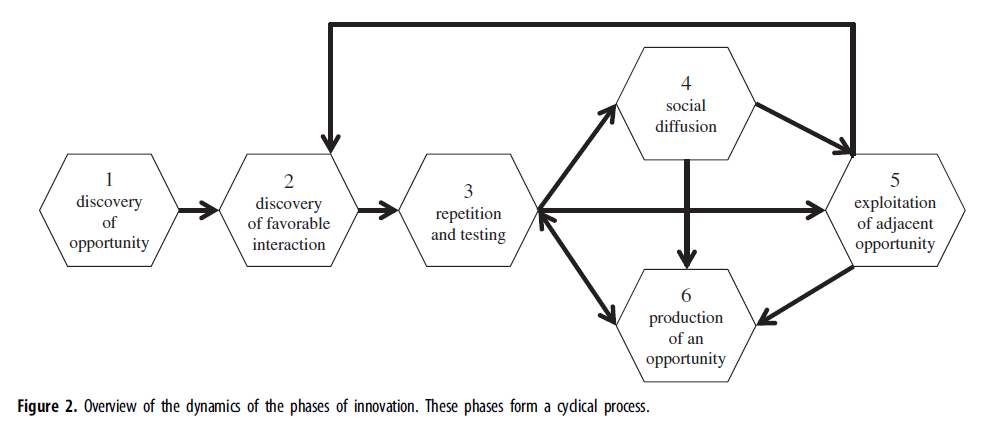Innovation
This note is about the concept of innovation.
Cf.
Definitions of Innovation
The concept of innovation relates to the objectives of Design, the notion of novelty, the notion of Creativity. An important idea here is that human pervasive neophilia is not necessarily a good thing.
How does one define innovation in non-anthropocentric terms? Innovation is not just what humans do and it is not very interesting to define it just by the process or actions, successful outcomes are more important than processes.
This is from an introduction to a special issue of Philosophical Transactions of Royal Society B, 2017.
"Innovation. A qualitatively novel phenotype associated with increased performance (performance innovations) or the establishment of a new ecological niche (niche innovations). Innovations have significant impacts on the environment (i.e. the surrounding community and ecosystem), and notably for niche or ‘key’ innovations, on subsequent lineage diversification."
"Invention. The appearance of a new phenotypic variant or the modification of an existing variant. The variant potentially contributes to producing a novelty. In biology, certain DNA mutations produce inventions, whereas in culture and technology inventions result from new ideas and discoveries."
Hochberg, Michael E., Pablo A. Marquet, Robert Boyd, and Andreas Wagner. ‘Innovation: An Emerging Focus from Cells to Societies’. Philosophical Transactions of Royal Society B 372, no. 1735 (2017): 20160414. https://doi.org/10/gfsp29.
"a conceptual framework for novelty and innovation, involving: (i)generation of the potential for novelty; (ii) the formation of novel attributes; (iii)refinement of novelties through adaptation; (iv) exploitation of novelties by a clade, which may coincide with a new round of ecological or environmental potentiation; followed by (v) the establishment of innovations through ecological processes. This framework recognizes that there is little empirical support for either the dominance of ecological opportunity, nor abrupt discontinuities (often caricatured as ‘hopeful monsters’). This general framework may be extended to aspects of cultural and social innovation."
Erwin, Douglas H. ‘A Conceptual Framework of Evolutionary Novelty and Innovation’. Biological Reviews, 2021. https://doi.org/10/ghrk9r.
Erwin, Douglas H. ‘Prospects for a General Theory of Evolutionary Novelty’. Journal of Computational Biology 26, no. 7 (2019): 735–44. https://doi.org/10/gf3fgz.
"Innovation is a solution to a novel problem or a novel solution to an existing problem"
Amici, Federica, Anja Widdig, Julia Lehmann, and Bonaventura Majolo. ‘A Meta-Analysis of Interindividual Differences in Innovation’. Animal Behaviour 155 (2019): 257–68. https://doi.org/10/gmr3wg.


In the context or with the intention to address human-child psychology but a useful review nonetheless. Focuses on 'behavioural innovation', but often silently extrapolates to all innovation, which is problematic.
Carr, Kayleigh, Rachel L. Kendal, and Emma G. Flynn. “Eureka!: What Is Innovation, How Does It Develop, and Who Does It?” Child Development 87, no. 5 (2016): 1505–19. https://doi.org/10/f88gvn.
In animals:
Innovation is "a process that results in new or modified learned behaviour and that introduces novel behavioural variants into a population’s repertoire".
Reader, Simon M., and Kevin N. Laland, eds. Animal Innovation. Oxford: Oxford University Press, 2003.
Cultural Innovation
"Cultural innovation is to cultural evolution what mutation is to biological evolution: without innovation, cultural traits and therefore cultural transmission would not exist."
Lehmann, Laurent, Marcus W. Feldman, and Rémy Kaeuffer. “Cumulative Cultural Dynamics and the Coevolution of Cultural Innovation and Transmission: An ESS Model for Panmictic and Structured Populations.” Journal of Evolutionary Biology 23, no. 11 (2010): 2356–69. https://doi.org/10/cfchhf.
In Living Systems
At the cell level.
"properties of versatile protein elements, weak linkage, compartmentation, redundancy, and exploratory behavior reduce the interdependence of components and confer robustness and flexibility on processes during embryonic development and in adult physiology. They also confer evolvability on the organism by reducing constraints on change and allowing the accumulation of nonlethal variation. Evolvability may have been generally selected in the course of selection for robust, flexible processes suitable for complex development and physiology"
Kirschner, Marc, and John Gerhart. ‘Evolvability’. Proceedings of the National Academy of Sciences 95, no. 15 (1998): 8420–27. https://doi.org/10/d39hh4.
"evolvability: the disposition to evolve; evolvability is generated by the properties of populations or individuals in those populations"
"Evolvability is the disposition to evolve, should the evolutionary forces that could cause evolution actually occur"
"disposition: the capacity to demonstrate a behavior or state under certain conditions, e.g., glass has a disposition to shatter when struck"
Houle, David, and Daniela M. Rossoni. ‘Complexity, Evolvability, and the Process of Adaptation’. Annual Review of Ecology, Evolution, and Systematics 53, no. 1 (2022): 137–59. https://doi.org/10/gst37c.

Castle, Simeon D., Claire S. Grierson, and Thomas E. Gorochowski. ‘Towards an Engineering Theory of Evolution’. Nature Communications 12, no. 1 (2021): 3326. https://doi.org/10/gkf45k.
Plasticity-led evolution.
Levis, Nicholas A., and David W. Pfennig. ‘Plasticity-Led Evolution: A Survey of Developmental Mechanisms and Empirical Tests’. Evolution & Development 22, no. 1–2 (2020): 71–87. https://doi.org/10/gst37s.
Animal Innovation
Animals can create new behaviour and cultures, also new tools. This is not surprising.
Ramsey, Grant, Meredith L. Bastian, and Carel van Schaik. ‘Animal Innovation Defined and Operationalized’. Behavioral and Brain Sciences 30, no. 4 (2007): 393–407. https://doi.org/10/cs3vmx.
Kaufman, Allison B., and James C. Kaufman, eds. Animal Creativity and Innovation. Amsterdam: Elsevier, 2015.
Reader, Simon M., and Kevin N. Laland, eds. Animal Innovation. Oxford: Oxford University Press, 2003.
Greenberg, Russell. ‘The Role of Neophobia and Neophilia in the Development of Innovative Behaviour of Birds’. In Animal Innovation, edited by Simon M. Reader and Kevin N. Laland. Oxford: Oxford University Press, 2003.

Tebbich, Sabine, Andrea S. Griffin, Markus F. Peschl, and Kim Sterelny. “From Mechanisms to Function: An Integrated Framework of Animal Innovation.” Philosophical Transactions of the Royal Society B: Biological Sciences 371, no. 1690 (2016): 20150195. https://doi.org/10/f3s3sq.
Anti-Innovation
The idea that humans trust their abilities too much, resulting in hubris and damage. There is a background to this in old priesthoods restricting knowledge, general conservatism, Luddism, neo-Luddism, noble savage, back to nature, and other such movements.
Relevant for the discussions of Design, Creativity, and Knowledge
Design often depends on 'ideational destruction'.
Tonkinwise, Cameron. ‘“I Prefer Not to”: Anti-Progressive Designing’. In Undesign: Critical Practices at the Intersection of Art and Design, edited by Gretchen Coombs, Gavin Sade, and Andrew McNamara, 74–84. Abingdon: Routledge, 2019.
The idea that there is not much innovation about the recent progress and the capitalist system in general, that it all depends on energy and specifically on fossil fuels.
Malm, Andreas. Fossil Capital: The Rise of Steam-Power and the Roots of Global Warming. London: Verso, 2016.
Angus, Ian. Facing the Anthropocene: Fossil Capitalism and the Crisis of the Earth System. New York: Monthly Review Press, 2016.
Moore, Jason W. Capitalism in the Web of Life: Ecology and the Accumulation of Capital. New York: Verso, 2015.
Cf. capitalocene
References
Reader, Simon M., and Kevin N. Laland, eds. Animal Innovation. Oxford: Oxford University Press, 2003.
Kaufman, Allison B., and James C. Kaufman, eds. Animal Creativity and Innovation. Amsterdam: Elsevier, 2015.
Backlinks